Diving Into the Product Satisfaction Survey
Diving Into the Product Satisfaction Survey
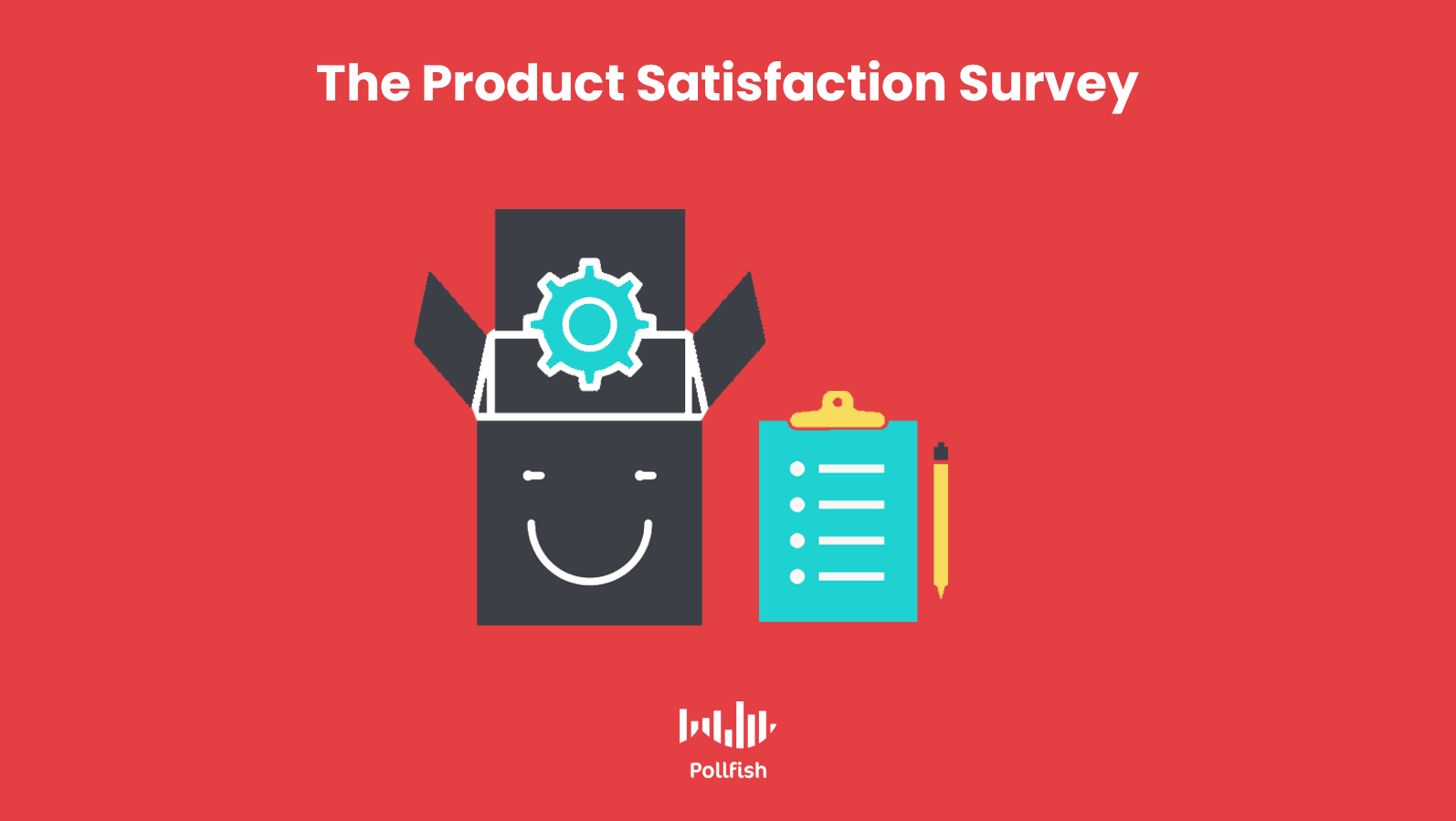
Diving Into the Product Satisfaction Survey
With the advent of online survey platforms, delivering a product satisfaction survey into the hands of your customers has never been easier. A product satisfaction survey provides insights that can help ensure the success of your product. Whether you need to measure the general opinions towards your product, its successes, ease or difficulty of use, points of friction, etc., conducting survey research will empower your business.
Product surveys are thus an essential part of your business upkeep. Routine use of product satisfaction surveys will help you create products that your customers will love and enthusiastically recommend to others.
This article will help you understand what you can achieve through a product satisfaction survey and present several tips on how to use the data that you amassed.
Defining Product Satisfaction
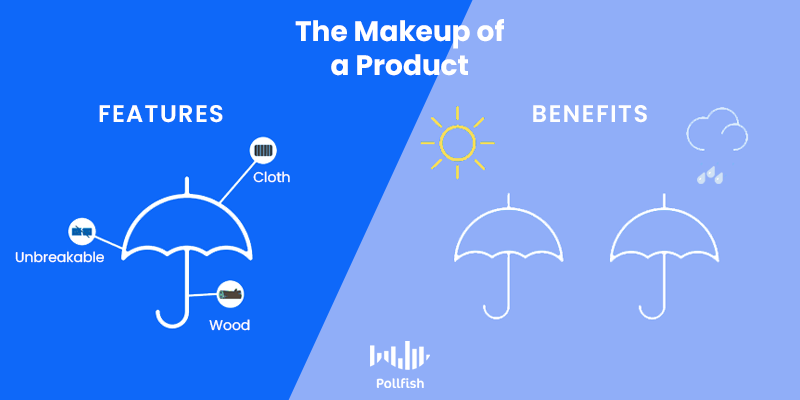
At its most basic level, a product satisfaction survey is used to measure how satisfied customers are with your product. This type of survey provides valuable information about how your product is used and how it can be improved.
Product satisfaction differs from customer satisfaction because it seeks to measure satisfaction with the product itself, rather than the entire customer experience While this type of survey focuses primarily on the product itself, you may also examine how your shopping, support, and return experiences affect your overall product satisfaction.
A product satisfaction survey provides candid feedback about the product, while also helping a company understand any discrepancy between the product and customer satisfaction, the latter of which you can determine with customer satisfaction surveys.
Insights Gained in a Product Satisfaction Survey
By focusing the questions on the product itself, a company can learn a great deal about how customers interact with a product. You may consider conducting a product satisfaction survey to:
- Glean insights into the user experience (UX) of your product.
- Understand what customers like and dislike about your product.
- See how your product compares to your competitors’ products.
- Discover how customers use your product.
- Decide how to improve the product.
- Identify features that are lacking or extraneous.
- Measure the useful lifespan of your product.
- Learn what factors lead customers to return your product.
- Understand how the product purchase experience affects overall feelings about the product.
- Determine how much customer support is needed to use the product.
- Gain insights during prototyping and product development to drive key decisions.
- Choose how to market your product to certain market segments.
Questions to Ask to Measure Product Satisfaction
When conducting a product satisfaction survey, you need to understand more than just how satisfied the customer is with your product. It is important to understand how demographics, product features, customer experience, and product retention affect your customers’ overall satisfaction with your product.
You can benefit from using a combination of long and short survey formats. For example, if you want to understand how customer satisfaction changes over time or during a product development cycle, deploying short surveys to anyone who purchased the product will yield a large number of responses.
For short surveys, the most important questions are:
- How satisfied are you with this product?
- How likely are you to recommend this product to a friend? (Also referred to as Net Promoter Score)
- Does the product fulfill the purpose for which you bought it?
- If you could change any part of the product, what would it be?
- Did you experience any problems when using this product?
A short survey can provide quick insights, but a longer survey will provide data that can help shape the future of your product. Below we outline the categories of questions that you should consider including in a more comprehensive product satisfaction survey.
Customer Demographics
During data analysis, you will want to segment and cross-tabulate your data to understand how product satisfaction correlates with various demographic data. Types of information to gather in your product satisfaction survey are:
- Customer age and gender
- Race and ethnicity
- Education level
- Employment status
- Salary range
- Employment type
- Organization type
- Geographic location
- Domestic relationship status
- Number of children
Product Satisfaction
Next, you will want to understand the overall satisfaction with your product. You should include questions that cover all or some of the following topics:
- Overall, how satisfied are the customers with your product (The CSAT format is typically used, measuring customer satisfaction on a scale of 1 to 10)
- How likely your customer is to recommend the product to a friend
- How your product compares to competitors’ products
- How likely your customer is to purchase the product again
- How easy is it is to use the product
Product Features
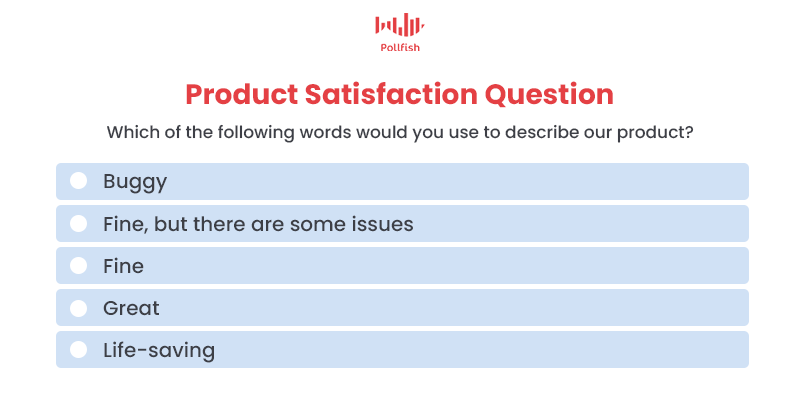
This section of the survey is the most useful in terms of understanding how to improve or develop your product further. By understanding how existing customers are using your product, you can make informed decisions about the features to include (or remove) in subsequent iterations.
In this section, you can benefit from asking a mix of multiple-choice/scaled and open-ended questions to maximize insights. When using multiple-choice questions, consider “piping” response text from a previous question to personalize the survey and gather deeper data.
Your questions should cover the following aspects:
- Why and when the product is used
- How often the product is used
- Which features are used most frequently
- Which features are missing
- What can be changed or improved about your product
Company experience
While the focus of the product satisfaction survey is on the product itself, it is important to understand how the customer’s experience with your company may negatively or positively affect their feelings about your product. Include questions about the following:
- The purchase experience
- Shipping, processing and returns
- Whether customer service or support was needed
- How well support teams managed the customer’s issue
Product Retention
A final aspect to consider is whether or not your customers tend to keep or return the product and how long it was useful to them. You may wish to include these questions with your product satisfaction survey to help cross-tabulate the data or use them as pre-screening criteria.
- What percentage of customers kept the product vs. returned it
- What are the reasons for returning the product
- The amount of time the product was used before it was discarded or no longer useful to the customer
How to Analyze Product Satisfaction Data
Once the results are in, it is time to start the process of survey data analysis. We’ll provide a brief overview of the data analysis process here. For further information, we encourage you to read our guide, How to Analyze Survey Data Like a Pro.
Survey data analysis is the process of organizing, reviewing, and drawing conclusions from your survey data. When it comes to a product satisfaction survey, you should follow these general steps:
- Review the purpose of your survey. You will have a lot of data to sift through, but staying focused on the data that will help answer your key questions will ensure that you answer your top questions.
- Review, filter, and use crosstabs. Review the data and think about how you will organize it. For example, you may wish to review all scale and multiple-choice questions first and save the open-ended responses for the end. You should use crosstabs reports to dive deeper into your data and understand how satisfaction levels vary between segments.
- Interrogate your data. Before drawing conclusions, take the time to examine your data for irregularities. Try to identify instances of sampling bias and ensure that your results are statistically significant before drawing any firm conclusions.
- Draw conclusions and create a plan for improvement. Based on the results of your survey, you can draw certain conclusions about your product. Once you have a deeper understanding of how satisfied your customers are with your product, you can create a plan to improve your product and/or the customer experience that surrounds it.
Investing in a Product Satisfaction Survey
While product satisfaction surveys are undoubtedly valuable in gauging satisfaction with an existing product, another important application of these surveys is during the product development cycle.
If you are developing a new product or considering how to innovate an existing one, product satisfaction surveys deployed during development allow you to test new features and validate decisions.
Product surveys are a relatively low cost and low effort research method, yet they are capable of yielding rich insights about your product. The results can be used to ensure your product will remain relevant in a competitive marketplace, thereby ensuring the success of your company.
Given all this, it should not be difficult to convince stakeholders to invest in a product satisfaction survey.
Frequently asked questions
What is a product satisfaction survey?
A product satisfaction survey is a type of customer satisfaction survey that focuses on how customers feel about a certain product.
What insights can be gained from a product satisfaction survey?
A product satisfaction survey can be used to gain wide-ranging insights about a product, including what customers like or dislike, how the product is used, what features are missing, how easy it is to use the product, and how to best market the product.
What is the Net Promoter Score?
The Net Promoter Score is a type of product satisfaction survey that results in a numerical value representing the overall customer experience. The survey asks just one question: “How likely are you to recommend our product/company/service to a friend or colleague?” The response is given on a scale of 1 to 10, with 1 being the least likely to recommend the product to a friend or colleague.
What can questions about product retention reveal?
In a product satisfaction survey, understanding why a customer returns a product can help the business understand how to improve their product or change marketing campaigns to ensure the product is purchased by the most appropriate customers.
How does product satisfaction differ from customer satisfaction?
Customer satisfaction levels can be influenced by a variety of factors, including the shopping and support experience. Product satisfaction surveys try to peel away these layers so they can focus on the customer’s satisfaction with the product itself.
All About Panel Surveys: Using this Method for Market Research
All About Panel Surveys: Using this Method for Market Research

Panel surveys (not to be confused with survey panels) are used in survey research as part of longitudinal studies. The purpose of this kind of study is to reap continual observations on different variables on the same sample pool over a period of time.
The variables include consumer feelings, attitudes and opinions regarding a number of matters. As such, the surveys are conducted across the same sample pool, i.e., the survey panel.
This way, the opinions of the same panelists can be monitored, as opposed to bringing in new respondents (even if they are part of the same target market). Panel surveys are conducted in waves (sequences of surveys) to measure changes in consumer thoughts and behaviors.
There are many key aspects of panel surveys; this article will cover all of them to help you decide on whether your business needs to use the panel survey method.
How Panel Surveys are Conducted
First off, panel surveys are but one type of longitudinal studies, which also include retrospective studies and record linkages.
As their name indicates, panel surveys use surveying as the data collection method. This data is mainly collected through the aforementioned survey panels, a method in which a pre-recruited pool of respondents agreed to take part in your survey.
However, panel surveys can also be collected through other online survey methods, mainly DIY survey platforms. These allow you to target a specific set of respondents, but unlike survey panels, they are not conducted among the same exact group of individuals. (More on this below).
Since panel surveys are longitudinal, this sampling pool stays the same and is used for repeated studies and observations.
Panel surveys are part of panel research and can take the form of either qualitative or quantitative studies for measuring consumer behavior.
The Pros of Panel Surveys
It’s worth considering several of the advantages that panel surveys carry when considering this surveying method. You ought to then weigh them against the disadvantages to determine if this is the correct survey route for your market research needs.
- Easy Collection of the Sampling Pool: Whether you intend to use an online survey platform or a survey panel, panel surveys make it easy to use a qualified sampling pool. That is because there is no need to look for respondents on an individual basis; instead, you either opt for recruited participants, or the online survey platform you use prescreens respondents for qualification.
- Longitudinal Benefits: As it follows the longitudinal survey method, panel surveys allow you to truly access the psyche of your target market. This is because consumers and the general public can change their minds — some more regularly than others. By conducting this survey research, you can stay up to date with any and all changes in attitude, thoughts and behaviors your target market undergoes.
- Speed to Insights: Online survey tools allow you to quickly garner all the respondents that match your screening requirements and demographics selections. A survey panel entails that respondents have already opted into the survey. In any case, getting results will be quick.
- Optimized Design: Whether you use an online survey panel or organic random sampling via a survey platform, each allows you to create customized questionnaires. The degree of this will change from one survey platform to the next, but the convenience of optimizing your survey to your favor is still present.
- Affordability: Panel surveys are relatively affordable. With online survey panels, you should be wise about how you incentivize your panel — this can be done by paying the panelists small amounts per each survey they take, or a larger sum for a set amount of surveys. A decent online survey tool should include several payment plans, with at least one perfect for your budget.
The Cons of Panel Surveys
While an invaluable form of primary research, panel surveys are not without setbacks. Here are a few of the disadvantages these surveys harbor. Some may appear minor, while others are more considerable.
- Panel Fatigue: Predominantly found in survey panels, this occurrence refers to the reduction of interest among the panelist(s) when they take part in too many survey waves. This breeds full-fledged boredom and exhaustion, leading to a decline in the quality of data. In this case, panelists may take part in flat-lining or other inaccurate answer tactics. There are 5 types of survey respondents like these to look out for.

- Limited Internet Traffic: A problem principally found in online survey tools, as they are under the heel of the publisher sites and apps that deploy the surveys. There may not be enough qualifying respondents in one site or app, depending on who visits it during survey distribution.
- Survey Attrition: Piggybacking off of panel fatigue as the most severe case of it, survey attrition alludes to the dropping out of a panel. Panelists may experience a negative UX with the panel, thereby attriting at any wave of the study. These respondents are especially difficult to replace in survey panels, as they’ve already provided some crucial data, so there will be a void when it comes to conducting further surveys based on their responses. Some panelists do not drop out permanently, as they may return to the panel at some later time. With online surveys, this is relatively non-existent, as new responders are screened in each survey wave.
- Inclination towards Bias: Particular to survey panels, this occurs when panel respondents have taken too many surveys, thus becoming programmed to the way your surveys are set up. As such, they become less like genuine research subjects and more like trained survey-taking professionals. They may not put forth too much effort or thought into further survey waves because of this; rather they will clamber to get out of a survey as soon as possible.
- Respondent Identity Fraud: Especially common in online survey tools where you cannot validate the identity of your sampling pool, this can lead to respondent fraud. Respondents may lie about their age, employment and any other type of demographic identifier. Your data will suffer as a result. Survey panels may be immune to this if you choose your panel via face-to-face interviews, or if you know any member of the panel.
- Panel Fatigue: Predominantly found in survey panels, this occurrence refers to the reduction of interest among the panelist(s) when they take part in too many survey waves. This breeds full-fledged boredom and exhaustion, leading to a decline in the quality of data. In this case, panelists may take part in flat-lining or other inaccurate answer tactics. There are 5 types of survey respondents like these to look out for.
Panel Surveys: Uses and Applications
Panel surveys have various applications that you can put to use for your brand. Whether you’re looking to innovate an existing product, develop a new one, understand how your target market responds to current affairs, how they respond to certain communications or virtually anything else you need data for, panel surveys are useful ind=struments to leverage.
Here are several specific uses and applications for these kinds of surveys.
- Detect common customer behaviors in relation to purchasing, clicking on an ad, or interacting with your brand in any other way (digital or physical).
- Analyze the costs of a product, service or subscription.
- Predict sales for particular campaigns and seasons.

- Understand how to use current affairs in brand messaging (including the knowledge of which subjects and rhetoric may be too sensitive for your target market).
- Monitor trends in how customers buy from brands.
- Find how recent and distant events have affected the attitude and opinions of your target market.
- Segmenting your target market.
Marrying Survey Panels and Organic Sampling
Closing off, it is crucial to reiterate that one of the key differentiators of panel surveys is their ability to incorporate two different types of survey respondent collection methods: survey panels and organic sampling (in online survey tools).
These fall into diametric opposition with one another, as the former involves recruiting willing survey respondents (the panel), while the latter uses organic sampling, in which respondents opt into a survey in real-time when they discover it in a website or app.
Although survey panels are the chief method to conduct panel surveys, due to the repeated nature of observation, both of these survey methods have the ability to sustain the longitudinal study method of panel surveys.
Survey panels are the primary collection method of responses, as panel surveys and other longitudinal studies involve studying the same group of respondents.
Survey panels do just that. However, survey tools that use organic sampling, can also study the same group based on their demographics and conditioned screening questions. The only difference is that the responders in organic sampling won’t be the exact same people, but rather those who fit the categories.
Either way these two methods can both be applied or even used hand in hand. We suggest using a robust online software tool that provides a wide range of features to optimize your survey research.
Frequently asked questions
What is a panel survey?
A panel survey is a type of longitudinal study that follows the behavior of a predetermined group of people over a period of time. In a panel survey, data is gathered through a series of surveys conducted at set intervals.
What is a longitudinal study?
A longitudinal study is a form of research that makes observations and gathers data over a period of time, rather than at one single point in time.
What variables are examined in a panel survey?
Panel surveys tend to track feelings, attitudes, and opinions to understand how they change over time or in response to certain stimuli.
What are some of the benefits of using an online survey panel?
Online survey panels are cost-effective, can be distributed quickly, allow for easy data compilation to discover insights and offer an optimized design to improve response rate.
What is panel fatigue?
Panel fatigue is a phenomenon that occurs when a survey panelist participates in too many surveys and then becomes tired or bored with the survey process. This can lead to inaccuracies in survey data.
Diving into the Employee Feedback Survey
Diving into the Employee Feedback Survey
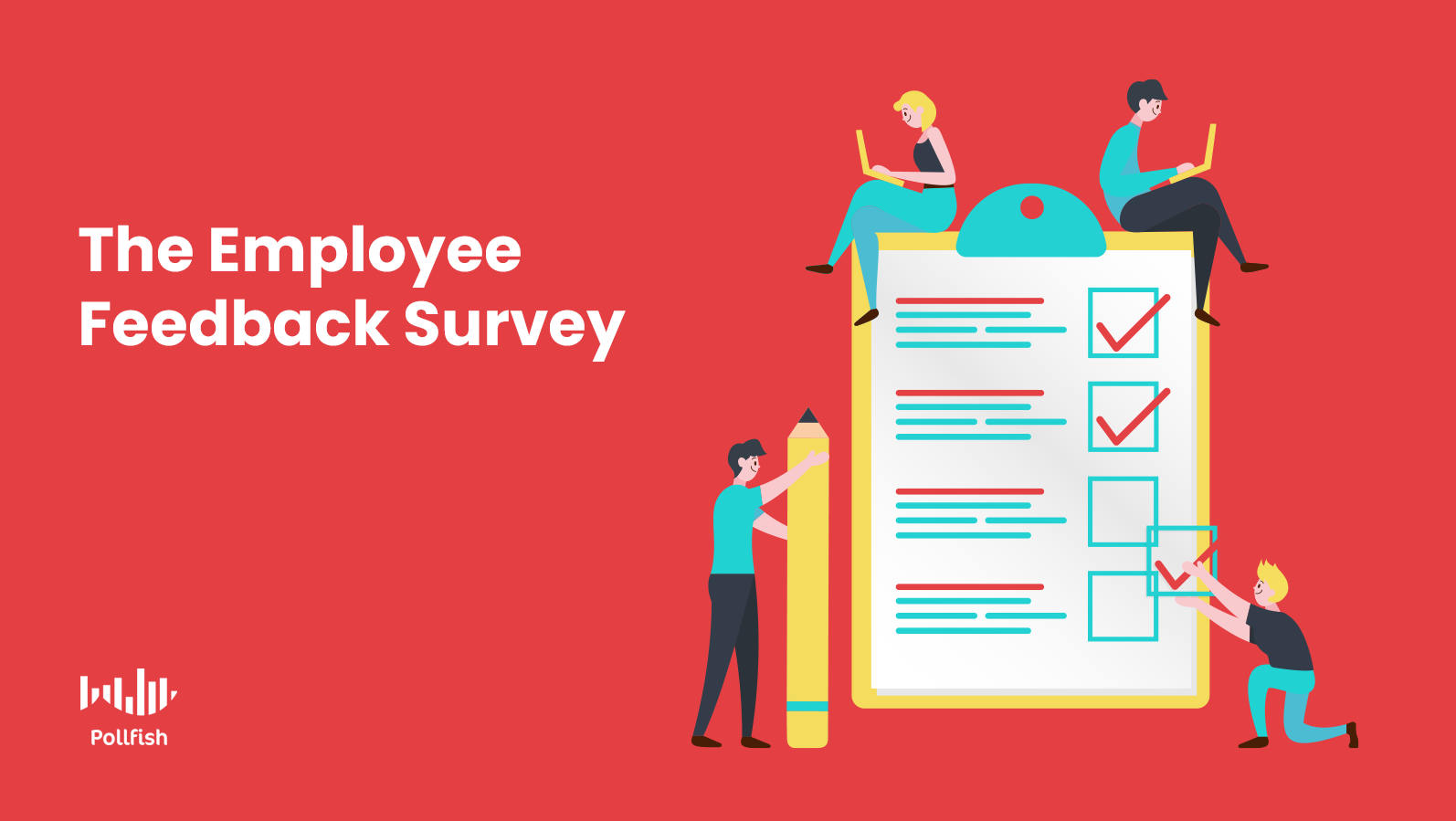
Whether you have five employees or 5,000, the employee feedback survey is an excellent source of collecting employee sentiment that allows you to improve business operations and employee retention in turn.
Feedback surveys provide employees with an anonymous way to share their concerns without fear of reprisal. In this format, a business can expect much more honest feedback that can drive meaningful change in the company.
Unfortunately, many employee feedback surveys fail because they do not ask the right questions or suffer from a low response rate. This guide will help you understand why these surveys matter and how you can make the most out of your next survey.
Employee Feedback Survey Overview
An employee feedback survey entails capturing feedback from existing employees in a survey format. This type of survey is also referred to as an employee engagement or employee opinion survey.
In general, employee feedback surveys seek to understand the level of job satisfaction, fulfillment and overall happiness that employees feel. Employee feedback surveys are conducted to understand employees’ holistic feelings toward a company or those pertaining to their team or department.
The results of an employee feedback survey are then used to help drive company action by improving companywide aspects such as management styles, HR methodologies, employee relations and interactions with clients.
There are many reasons why a company may choose to conduct an employee feedback survey. Some of the main motivations include:
- Understanding current pain points
- Measuring overall job satisfaction
- Gaining insight into successful management styles
- Learning which HR incentives are most appreciated by employees
- Improving processes for hiring and onboarding new employees
- Demonstrating to employees that the company is interested and invested in improving their experience
- Giving employees the opportunity to reflect and volunteer ways to improve their role or the company
- Improving the general satisfaction employees feel with their work and work environment
Benefits of Employee Feedback Surveys

Companies of all sizes can benefit from conducting an employee feedback survey and acting on the insights uncovered during the analysis process. Benefits companies may experience include:
- Better performance: your team may feel more motivated to perform when they are given the opportunity to provide employee feedback.
- Eliminating any discomfort employees feel about raising their concerns on employment particulars.
- Detecting problems before they occur.
- An improved and streamlined communication between management and employees.
- Helping employees feel they belong and have a sense of purpose within the business.
- Boosting employee retention rates.
- Attracting prospective employees who want to be part of a culture where their voice is heard.
Additionally, there are added benefits of administering surveys on a more regular basis. The benefits of more frequent employee feedback surveys include:
- Having a system of benchmarks to understand how employee satisfaction changes over time.
- Identifying changes in HR or operation procedures that have positively or negatively impacted employees.
- Giving employees more frequent opportunities to voice their concerns.
How to Conduct an Employee Feedback Survey
Employee feedback surveys are relatively easy to conduct and follow a similar process to other survey types.
- Understand the purpose of your survey and write down your goals. Before you begin to pen your questions, explore your motivations for conducting an employee feedback survey. Then write down what you hope to accomplish or learn by the end of your survey.
- Identify your target audience. Determine if you will distribute your survey to the entire company or to smaller segments. Your target audience will influence the questions in your survey.
- Organize and plan your survey(s). Depending on the purpose of your survey and the target audience(s) you identify, you may need to create more than one survey. For example, if you are creating a survey for a large company with several offices, you may want to create individual surveys for each office or for each team within the offices. The questions that you ask managers are also likely to differ from those that you will ask team members.
- Create your questions and design your survey. With the purpose and audience of your survey in mind, create questions that will provide the data you need to drive change. The design of your survey matters too; consider using a professional survey platform to make the process easier for the employees and, thereby, improve your survey response rate.
- Distribute your survey. Before sending the survey out, it is a good idea to explain to your employees why you are conducting the survey. This should encourage employees to take the time to complete the survey and provide thoughtful answers.
- Perform survey data analysis. Once the responses are in, you will need to collate, organize, and analyze the responses in order to draw conclusions for your business. We encourage you to read our in-depth article about survey data analysis to learn more about this process.
- Put the insights into action. With the analysis complete, you should be able to draw some conclusions and put them into action. Circle back with your employees and share the results of the survey and explain how you will use these insights to improve the company.
Questions to Include in Employee Feedback Surveys
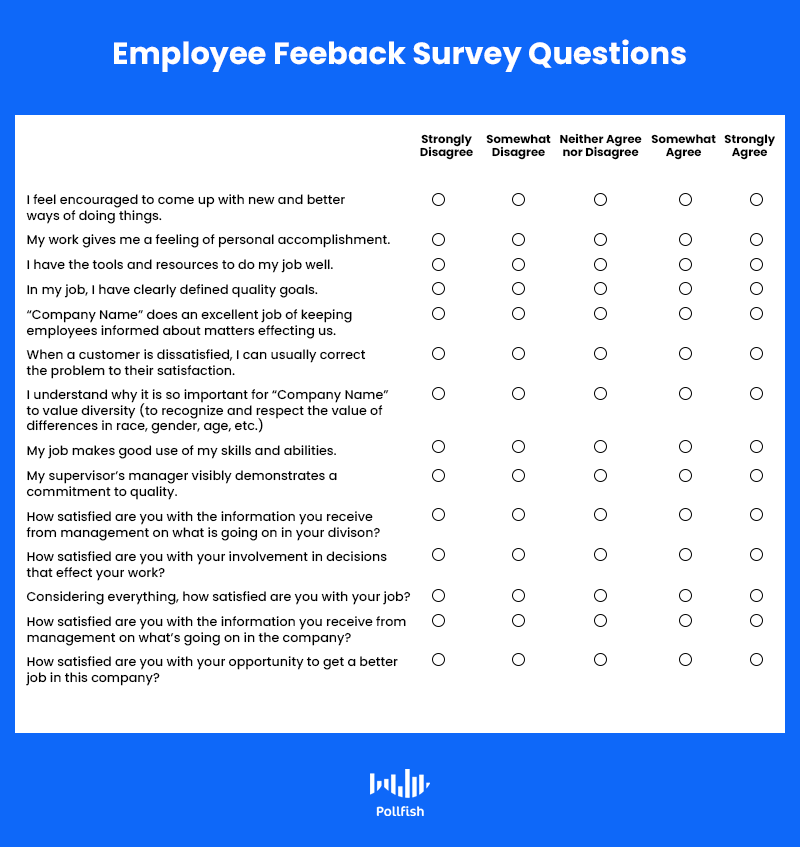
By asking the right questions, you are more likely to get insightful responses that can help drive positive and impactful change in your organization.
The wording of your questions is important. In order to get helpful responses, be sure to ask questions that require specific responses. Don’t try to kill two birds with one stone; keep questions focused on one topic at a time.
To help get you started, we have compiled a list of questions covering some of the topics you may wish to include in your next employee feedback survey.
Overall Job Satisfaction
- Have you considered looking for another job within the past three months? If yes, please explain why.
- What’s the one thing you would change about your job?
- On a scale of 1 - 10, how happy are you with your job?
- Are you happy with your work-life balance?
- Would you refer a friend or colleague to work at this company? If no, please explain why not.
Relationship with Management
- On a scale of 1 - 10, how would you rate your manager’s performance?
- Are you happy with the level of communication between senior management and the team?
- Do you know where to turn for help when you have a problem or challenge?
- Do you feel recognized for the work you do?
Performance and Motivation
- On a scale of 1 - 10, how challenging do you find your job?
- What is the most challenging aspect of your job?
- Do you feel inspired to do your best work?
Boost Your Business with the Employee Feedback Surveys
Employee turnover is expensive. Not only is it expensive and time-consuming to hire and train new employees, but companies with a higher turnover rate will experience lower overall profits.
An employee feedback survey is an incredibly valuable tool that can help keep your employees engaged with your business. By investing in your people and understanding their true feelings about their role in your company, you can ensure the success of your business for years to come.
The simple act of conducting the employee feedback survey alone can help boost morale within your team. Add the free insights you’ll get from your employees, and it makes conducting an employee feedback survey a no-brainer.
A professional survey platform can make it even easier to distribute your survey to a vast network of online users and assure that your survey collects the exact number of responses that you need. There is nothing holding you back from getting started today!
Frequently asked questions
What is an employee feedback survey?
An employee feedback survey is a survey that collects feedback from existing employees in order to understand their overall level of job satisfaction.
What are some of the reasons for conducting an employee feedback survey?
Some of the reasons a company may conduct an employee feedback survey are to measure job satisfaction, understand frustrations, improve processes, and show employees that the company cares about their concerns.
What are other names used to describe an employee feedback survey?
Employee feedback surveys are also referred to as employee engagement surveys or employee opinion surveys.
What are some of the topics that an employee feedback survey should cover?
Employee feedback surveys typically ask questions about overall job satisfaction, relationship with management, and employee performance and motivation.
Who participates in an employee feedback survey?
An employee feedback survey can be distributed to all employees of a company, or it can be distributed to smaller groups of employees, such as certain departments or office locations.
The Business Survey Question Guide
The Business Survey Question Guide

Well-designed business survey questions can reveal deep insights about your company, product, or service. Business surveys can help you focus your research so you can make smart growth decisions.
A good business survey can support unparalleled growth. Any business owner who wants to improve or grow their business can benefit from conducting regular business surveys.
In order to gain actionable insights, however, you need to ask the right questions. This guide explains how to create the right business survey questions for your target market, the kinds that will elicit valuable responses.
What is a Business Survey?
When conducting any type of business survey, your goal is to gather information and insights that will help you understand and improve specific aspects of your business. The questions that you include will depend upon your motivations for conducting the survey.
Business surveys are used in a variety of ways. They are frequently used to understand how well your company is meeting the needs of your target market. You may use them to better understand your existing market or explore new ones. A business survey is also used to understand company operations and/or employee satisfaction in order to improve processes.
By asking the right questions, you can gather specific insights that can help you grow your company. We’ll dive into the different types of surveys and provide you with sample business survey questions to help you create your own business survey.
Customer Satisfaction Survey
One of the most common types of business surveys, customer satisfaction surveys seek to measure how satisfied your customers are with your product, services, or company as a whole. We will cover the four primary types of customer satisfaction surveys here.
Customer Satisfaction Score (CSAT)
 The Customer Satisfaction Score survey assesses customer satisfaction with your company, product, or service. The survey contains a small number of questions that directly relate to the customer's experience. The responses on a CSAT survey are done on a scale, typically, 1 - 5 or 1 -10.
The Customer Satisfaction Score survey assesses customer satisfaction with your company, product, or service. The survey contains a small number of questions that directly relate to the customer's experience. The responses on a CSAT survey are done on a scale, typically, 1 - 5 or 1 -10.
Examples of CSAT questions include:
- How satisfied are you with your purchase of [product name]?
- How satisfied were you with our checkout process?
- How satisfied were you with your recent experience with our support team?
Net Promoter Score Survey (NPS)
The purpose of a net promoter score survey is to determine how likely it is that existing customers will recommend your company, product, or service to a friend. Much like the CSAT, this type of survey is also scale based, but there is only one scale (1-10). A positive NPS score is a good indication of how satisfied your customers are with your company.
Sample questions include:
- On a scale of 1-10, how likely would you be to recommend [product name] to a friend?
- On a scale of 1-10, how likely are you to recommend [company name] to a friend or colleague?
Customer Effort Score Survey (CES)
Using the Customer Effort Score (CES), this metric-based survey measures how much effort is required for a customer to use your product or interact with your company (e.g. with a help desk or sales rep). These questions use a 5-point scale to determine the effort score.
Examples of CES questions are:
- Overall, how easy was it to solve your problem with [company name] today?
- How easy was it to [state action here]?
Visual Rating Surveys
This type of survey uses emojis (e.g. hearts, starts, emojis) to quickly gauge customer feedback during or after an experience with your company.
Some examples include:
- How would you rate your experience with our customer service team today? (Happy face / neutral face / sad face)
- How happy are you with your recent purchase of [product name]? (User is able to select any number of the 5 stars displayed)
Market Research Survey
Often included in market research, market research surveys are conducted in order to better understand the market for your product or service. You may conduct a market research survey in order to plan an effective marketing campaign, determine viability for a new product or feature, or identify new customer segments.
The purpose of your survey will influence the type of questions you want to include. It is important to include demographic questions in your survey to help you better understand the market.
Example of market research questions include:
- Where do you live?
- How old are you?
- How long have you been using [product name]?
- Would you recommend [product name] to a friend?
- How much money do you usually spend on [product category]?
- What is your least favorite thing about [product name]?
Employee Satisfaction Survey
An employee satisfaction survey is an excellent source of information for improving both employee retention and business operations. If you deploy this survey to the entire company, it is important to include demographic information to help draw more accurate conclusions.
Example questions include:
- On a scale of 1 - 10, how happy are you with your work-life balance?
- Do you feel that your role and responsibilities are well-defined?
- Have you thought about looking for a new job in the past 6 months?
- What reasons would you have for looking for a new job?
- Do you feel that your workload is reasonable?
- On a scale of 1 - 10, how supportive is your manager when you have a problem?
- Do you feel comfortable discussing a problem or issue with your manager?
- What is the most challenging part of your job?
- Do you feel appreciated for the work you do?
- If you could change one thing about your job, what would it be?
Brand Awareness Survey

You can conduct a brand awareness survey to measure the recognition and awareness of your brand amongst your target audience or consumers in general. Brand awareness surveys can help you plan effective marketing campaigns and identify new sectors for growth.
Questions to include in this type of survey are:
- Which of the following brands have you used?
- Which of the following brands have you heard about?
- Do you currently use [product category]?
- When is the last time you used [product category]?
- Have you heard of [company/product name] before?
- How likely are you to switch to [competitor brand] should they offer cheaper prices?
- Which brands would you use for [a need, an industry practice or service]?
- How was your experience with our [company/product]?
- Of the following brands, please select the one that you feel is the best.
- How likely are you to recommend [company name] to a friend?
Product Satisfaction Survey
The product satisfaction survey focuses on how satisfied your customers are with your product. The questions should be designed to help you gauge overall satisfaction, see how your product measures up to its competition, and understand how you can improve your product.
Examples of product satisfaction survey question include:
- How long have you used [product name]?
- How long have you been using our product?
- How frequently do you use [product name}?
- How happy are you with [product name]?
- On a scale of 1-10, how well does [product name] meet your needs?
- What is your favorite thing about our product?
- What do you dislike about our product?
- How likely are you to recommend [product name] to a friend?
- Which of the following features do you use?
- What would you improve about our product?
Best Practices for Creating Business Survey Questions
We hope that these business survey questions will inspire you to create your own business survey to gain new insights about your target market, for various businesses needs. In order to leverage these questions to uncover valuable insights, we will leave you with some best practices for creating survey questions:
- Before creating your questions, determine and write down the purpose of your survey. Each question should support the survey’s purpose.
- A short, focused survey will achieve a higher response rate. You may get better results by deploying several short surveys, rather than trying to get all the answers from one, long survey.
- Ensure that each survey question is clear and well-written so respondents do not spend unnecessary time trying to understand the question.
- Make sure your question responses are appropriate for the question type.
Make an Impact with the Right Business Survey Questions
Business surveys are a cost-effective tool that businesses can utilize to improve the customer experience (CX), streamline internal processes, and increase profitability. The advent of professional online survey platforms has encouraged many businesses to conduct surveys on a routine basis to establish benchmarks and monitor improvement.
While these tools make it easy to deploy surveys, they will not provide the answers you need unless you take the time to create thoughtful business survey questions. Each question must relate back to your survey’s purpose in order to focus your findings.
When you start by creating a business survey with the right kind of questions, you can expect your survey to reveal deep insights that will have a positive impact on your business.
Frequently asked questions
What is a business survey?
A business survey describes a wide variety of survey types that are performed in order to help a business gain insights about their company, products, and/or services.
What are some examples of business surveys?
Examples of business surveys include customer satisfaction surveys, market research surveys, employee satisfaction surveys, brand awareness surveys, and product satisfaction surveys.
What is a Customer Satisfaction Score (CSAT)?
A Customer Satisfaction Score (CSAT) is a type of business survey that measures customer satisfaction with a company, product, or service via numerical, scaled responses. The result of the survey is represented as a numerical value of 1-5 or 1-10. (i.e. “satisfaction score).
What is a brand awareness survey?
A brand awareness survey is a type of business survey that is used to measure a brand’s overall recognition within a target market.
What can be done to encourage a higher response rate for business surveys?
A short, focused business survey that contains well-written questions may achieve a higher response rate than a longer survey.
Diving Into the Net Promoter Score (NPS) Survey
Diving Into the Net Promoter Score (NPS) Survey

The Net Promoter Score (NPS) survey is one of the most prominent customer satisfaction surveys. Based on its eponymous score, this survey measures one of the most critical aspects of customer satisfaction: loyalty.
While brand awareness and product / experience satisfaction are invaluable for any business, loyalty is the only guaranteeing factor that assures your customers will return to your brand for future purchases. As a matter of fact, 43% of customers spend more on a brand that they’re loyal to.
Brands should thus keep track of their NPS score, as it is one of the top indicators of customer loyalty. The best way to do so is by running NPS surveys. This article will take a deep dive into this survey type and guide you on several best practices.
Defining the Net Promoter Score
As its name indicates, the Net Promoter Score survey is a survey based on its titular Net Promoter Score. The score is a key customer satisfaction metric, as it reveals how likely a customer is to recommend a product or company to a friend or colleague.
The score is derived by asking just one question, known as the Ultimate Question in relation to the above. The responder answers the question using a scale of 0-10. 0-6 is the low end of the scale, denoting negative sentiment towards the brand and thus a low chance of receiving a customer’s recommendation.
Conversely, 9-10 is the higher end of the scale, signifying a high chance of customer satisfaction and recommendation of the company. 7-8, although they appear on the higher end, are known to be the mid-range.
This scale is only one aspect of the NPS, as it requires using respondents’ combined answers to find the score in a particular study. Thus, an NPS survey is the vehicle used in obtaining and enriching this score.
Let’s observe the nuances of the NPS score and how to calculate it.
How to Calculate the NPS and its Numerical Significance
Delving into the specifics of this score, you’ll find that the numbers represent more than just the “not likely” and “extremely likely” points of view.
On the contrary, the NPS score designates several types of customers based on their answers: the detractors, the passives and the promoters.
It also requires a calculation, as the respondents’ answer itself does not represent the final score. First, you’ll need to know the customer classification in the NPS, which is based on the answers the respondents give. Here is the numerical significance for each answer range:
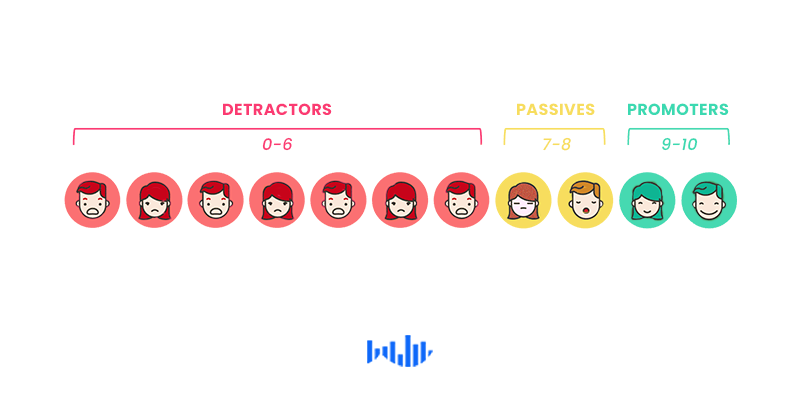
- 0-6: The Detractors: The most unlikely group to recommend your company or product.
- Unlikely to stay on your website for long or make repeat purchases
Tend to be naysayers, which means they can intentionally discourage other customers from buying from your brand. - Can spread negative opinions about your brand on social media, forums or word of mouth.
- 7-8: The Passives: The somewhat satisfied group of customers susceptible to buying from your competitors.
- Won’t actively recommend your brand, yet aren’t likely to harm it with negative feedback.
- Not used in the NPS calculation.
- Close to being promoters (especially if they respond with an 8)
- Opportune for brands to study and nurture this group, as they are the easiest to convert to promoters.
- 9-10: The Promoters: The most loyal customers who make continuous purchases from your brand and refer others to it.
- Most likely to act as brand ambassadors and augment your brand’s reputation.
- Most responsible for a company's growth.
- Increase referrals, thereby increasing brand awareness.
You will need to understand these to calculate the Net Promoter Score. Here is how to do so:
- Subtract the percentage of Detractors from the percentage of Promoters.
- For example, if 15% of respondents are Detractors, 20% are Passives and 60% are Promoters, your NPS score would be 60-15 = 45.
- The NPS= 45, as it is always represented as a digit, not a percentage.
- A higher NPS score points to a larger amount of promoters, which is most ideal.
The NPS Survey Measures & Correlates with Growth
A Net Promoter Score survey puts the score to greater use by providing it with context. As such, this type of survey does not merely ask the Ultimate Question; it can ask more for a more lucid context.
This is to say that despite the NPS being the bulk of an NPS survey, it is just that: a part of it but not its entirety. This survey is capable of not only measuring growth but it has proven to correlate with it.
According to Bain & Company, which devised the Net Promoter System, the score can determine growth. Bain conducted a study on the correlation between the NPS and organic growth, measuring this score among business competitors in different industries
Bain concluded that the NPS correlated with 20%-60% of organic growth among these competitors. What’s more is that Net Promoter Score leaders went on to outgrow their competitors by more than twice.
This proves the urgency of tracking one’s NPS and a Net Promoter Score survey helps do just that. This score will enlighten your business on how to improve on several fronts. To understand how you must understand the other questions and facets of an NPS survey.
The Components of an NPS Survey & How they Provide Key Insights
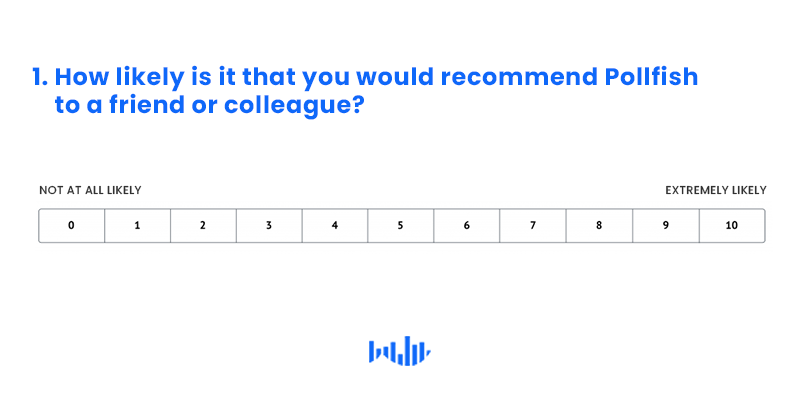
Aside from asking the Ultimate Question, there are a few other capabilities you can configure to fortify your customer satisfaction measurement. These will provide much more context than a number (the NPS) can alone.
Here are some other ways your business can benefit from a Net Promoter Score survey based on its components.
- You can set up the NPS survey to measure virtually anything instead of simply obtaining a general NPS for your brand. You can use it measure:
- Products
- Interactions with representatives
- UX
- Brick and mortar stores & more
- If looking for insight into something specific, you can implement the NPS survey in various parts of the customer journey, such as:
- The homepage
- A landing page
- A product page
- At checkout
- Post checkout/purchase
- You can perform market segmentation by using demographics as part of your survey. This will help you create groupings of respondent answers based on their demography. You can thus make educated deductions on how your NPS answers correlate with different demographics.
- The added questions. You can use the survey to extract key contextual information that a score alone wouldn’t grant you, such as:
- Finding the exact reason behind a respondent's number. For example:
- What are the main reasons for the score you gave us?
- What makes you feel this way?
- Improving customer and user experience. For example:
- What can Pollfish do to improve your experience?
- How can we improve this product, interaction, etc?
- Following up with the respondents to learn more about their concerns on a more granular level. For example:
- Can we follow up with you about your responses?
- Can we follow up with you to see how we can improve your experience?
- Finding the exact reason behind a respondent's number. For example:
Transactional vs Relational NPS Surveys
Now that we’ve established and elucidated the utility and importance of Net Promoter Score surveys, let’s examine the two main types of NPS surveys.
These surveys are classified as relational and transactional NPS surveys. They are categorized based on both their frequency and purpose of deployment.
- Relational NPS Surveys:
- Deployed periodically, such as every quarter, annually or monthly.
- Designed to keep regular track of customer sentiment, find patterns and detect changes in attitudes toward your brand overall.
- Provide “health check-ins” on customers as a way to measure success.
- Transactional NPS Surveys:
- Distributed after a customer interacted with your company (ex: post purchases or conversation with a representative).
- Used to understand customer satisfaction in more depth.
- Based on specific topics.
The success of your brand depends on using both of these types of surveys to fully comprehend your customer loyalty. If you rely on sending out various transactional NPS surveys, then you ought to adjust your relational surveys to a lesser frequency.
If you rarely deploy transactional surveys, you should dispense more frequent relational surveys. To find the correct balance of using both, examine all of your survey feedback. Look for things you find to be missing and once you do, determine which type of survey these concerns best fall under.
Customer Loyalty and Long-Term Business Success
The main insight you can glean from Net Promoter Score surveys is how loyal your costumes are, and of course, how many customers can damage your reputation.
Through more detailed questions, you can pinpoint the reasons behind your customers’ satisfaction or dissatisfaction with your company as a whole or a particular component.
This allows you to innovate better, augment your offerings and fix any bugs (whether it’s with an online experience, a salesperson or any other feature). As mentioned above briefly, one of the benefits of this type of survey is its versatility; it can be used to measure satisfaction with just about anything.
The goal is to use the insights you’ve acquired through this survey to gain loyal customers, the kinds who transcend the notion of “customer,” by becoming brand evangelists.
Frequently asked questions
What is the Net Promoter Score (NPS) survey?
The Net Promoter Score (NPS) survey is a type of survey that seeks to understand customer satisfaction by measuring how likely it is that a customer will recommend a product, company, or service to a friend or associate.
How many questions are included in the NPS survey?
The NPS survey typically requires just one question, which asks: “How likely are you to recommend [company, product, or service name] to a friend or colleague?” Researchers can expand on it, so it resembles a full-fledged survey by adding more relevant questions.
How is the Net Promoter Score calculated?
The Net Promoter Score is calculated by subtracting the percentage of Detractors from the percentage of Promoters. Respondents who gave a Passive response are not included in the calculation. The NPS is then described as a number rather than a percentage.
How can the NPS predict growth?
Studies have demonstrated a correlation between a high NPS and organic growth. Those who achieved high Net Promoter Scores tended to outpace their competitors in organic growth.
What types of businesses can benefit from conducting a NPS survey?
All types of businesses can benefit from using an NPS survey. Brick and mortar stores and online shops can benefit equally, as can those selling any type of product or service.
How to Use the New Carry Forward Feature for an Enhanced Survey Experience
How to Use the New Carry Forward Feature for an Enhanced Survey Experience

As the heart of any survey, the questionnaire must be contrived carefully so that you receive the responses most necessary for your survey research. Creating the questions themselves can be difficult, especially if you choose to create question paths.
Pollfish is thus thrilled to present a new feature to make building the questions a much easier task: Carry Forward. This new attribute provides advanced piping capabilities to optimize your questionnaire experience.
The Purpose of the Carry Forward Feature
As a refresher, piping is a functionality that allows users to place, aka, “pipe,” a part of a question or answer into a subsequent question or answer.
In the Pollfish platform, piping works by taking the answer(s) from the sender question and inserting them to the receiver question.
In the first piping iteration, researchers were able to funnel answer choices from one question to another based on respondents’ selections. The following question would carry forward answers from previously piped answers.
The new Carry Forward feature carries (no pun intended) the function of enriching the question-building experience, as it allows you to pipe questions on more question and answer types, along with other capabilities.
This new feature helps researchers design specific questions that are more relevant to the respondent’s behavior, and more useful to their research.
It functions on both selected and unselected answers. It also can be used with:
- Matrix questions
- Ranking questions
- Single selection questions
- Multiple selection questions
Laying Out the Carry Forward Capabilities
Multiple Selection Questions
Along with carrying forward selected answers, this feature allows researchers to carry forward all the answers that the respondent did not select.
In the case of a multiple selection question, for example, the feature can carry forward the unselected answers into the receiver question.
Due to this, when a responder selects all the answers and proceeds, there will be no answer to carry forward, as there are no remaining unselected answers. For this precise reason, the Pollfish platform has developed a validation which exists as a dialogue box.
This pop-up allows the researcher to know that the Carry Forward feature cannot support this case, as it only works if at least one answer is unselected. This is due to the condition that unselected answers cannot be carried forward if all the answers have been selected.
Advanced Logic
This can be used in tandem with advanced logic, allowing you to augment your survey with multiple layers.
Enabling advanced logic (ADL) can trigger questions without forwarded answers. For example, when Carry Forward is enabled but a respondent skipped the sender question, the respondent will then be routed to a question without Carry Forward answers
Pollfish has also added front end validation that disables the researchers from proceeding with the previous structure.
Sender questions with either the “None of the above” or “Other” option must be structured correctly, that is, with multiple selection questions. If these aren’t added to the proper question, there will be pop-up error messages.
Carry Forward Answers that Contain Media
If the Carry Forward answer type is the same or similar to the source (question) type, such as:
- single to single,
- multiple to multiple,
- single to multiple, etc.,
then the platform will carry forward the media files together with the answers.
In other cases, such as different types between sender & receiver questions, there are certain conditions and rules that dictate how Carry Forward will work.
How to maneuver Carry Forward answers which contain media:
- If the Carry Forward answer type is the same or similar (single, multiple) to the source type ? the media will be carried forward.
- If the Carry Forward answer type doesn’t support media then:
- The text will be carried forward if the source answer contains both text and media.
- Carry Forward will not be supported if the source answer contains only media.
How to Add Carry Forward to Your Questionnaire
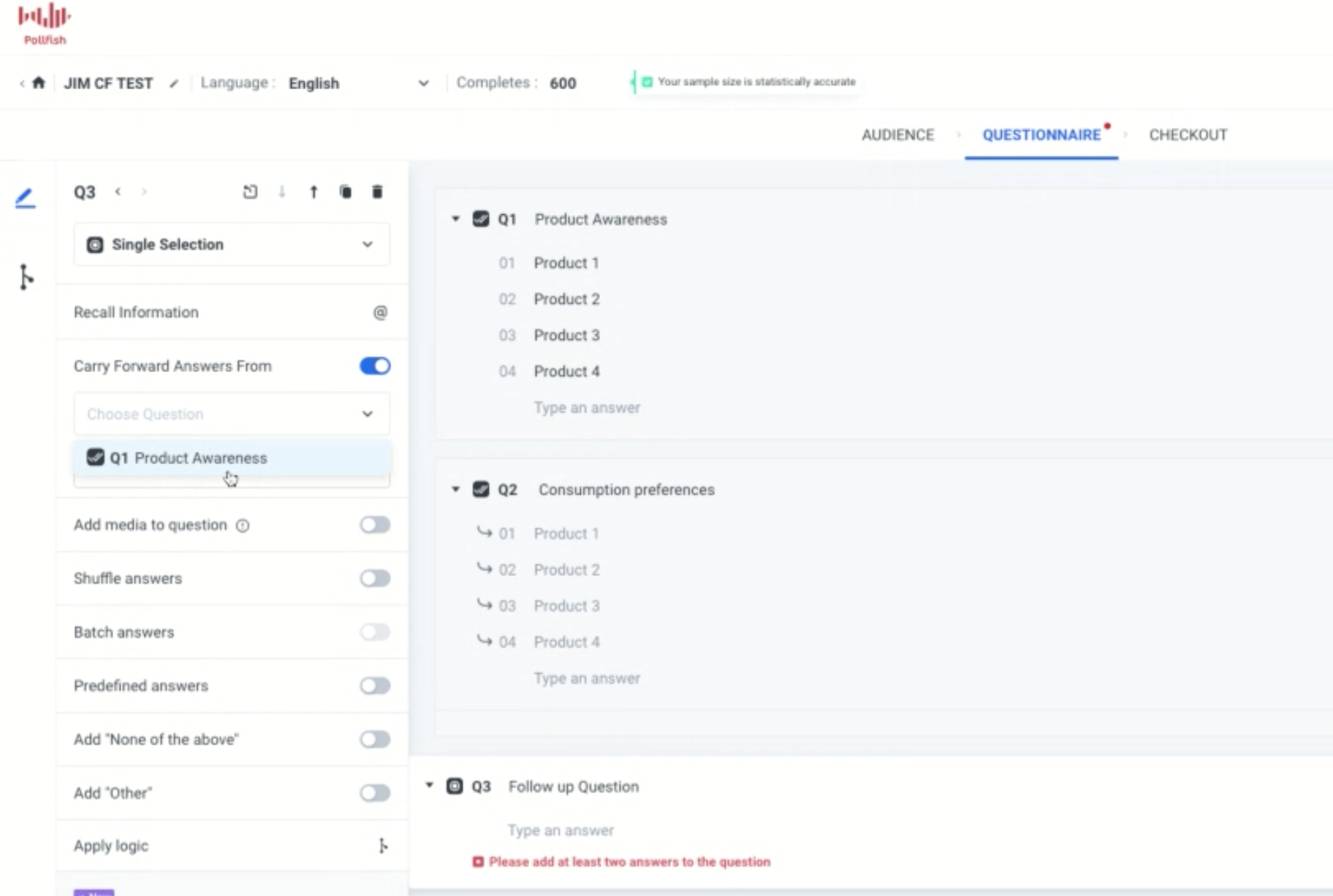
In order to add the Carry Forward feature, you’ll need to enter the questionnaire portion of the survey first (after completing the audience section). You’ll also need to have your questions and answers in mind.
You can add Carry Forward when you begin the questionnaire, as you’ll need at least two questions to use this feature, the sender and receiver question. You can also implement it to an existing questionnaire.
- Find the Carry Forward option at the left panel of the questionnaire.
- Find a sender and a receiver question you wish to apply the CF feature to. This can be in any order. For example, you can use Question 1 as the sender question and Question 2 as the receiver question.
- Enable this via the receiver question and select “Carry Forward” and then the selected or unselected answers from a previous question (the sender question).
What Carry Forward Supports Vs. What It Does Not Support
There are certain conditions that need to be met in order to apply the Carry Forward function. There are certain circumstances in which your questions will not be able to implement Carry Forward.
What it supports:
- Carry Forward can be used with single/ multiple/ ranking/ matrix questions when they are designed as receiver questions.
- When you carry forward a matrix question, there’s an additional option to narrow the choices based on selected columns, unselected columns, rows for selected columns, rows for unselected columns, and columns for specific rows.
- It is supported by single, multiple, open-ended, numeric, ranking, matrix, slider and OE when they are set up as sender questions.
- The researcher can carry forward all the questions that the respondent didn’t select.
- There is simultaneous support of advanced logic and Carry Forward.
- It supports Order/ Shuffle answers for funneling questions.
What it doesn’t support:
- Carry Forward cannot be used with description questions, Net Promoter Score (NPS) surveys and visual ratings surveys.
- It does not support screening questions and therefore cannot be used in them.
- It does not support the option of “Group and Randomize.”
Note: Closing off, you should know that responses that are carried forward will be treated the same as other answer choices on the results page.
We suggest you preview your survey design before submitting the survey itself. Try it out!
The Complete Guide to Qualitative Market Research
The Complete Guide to Qualitative Market Research
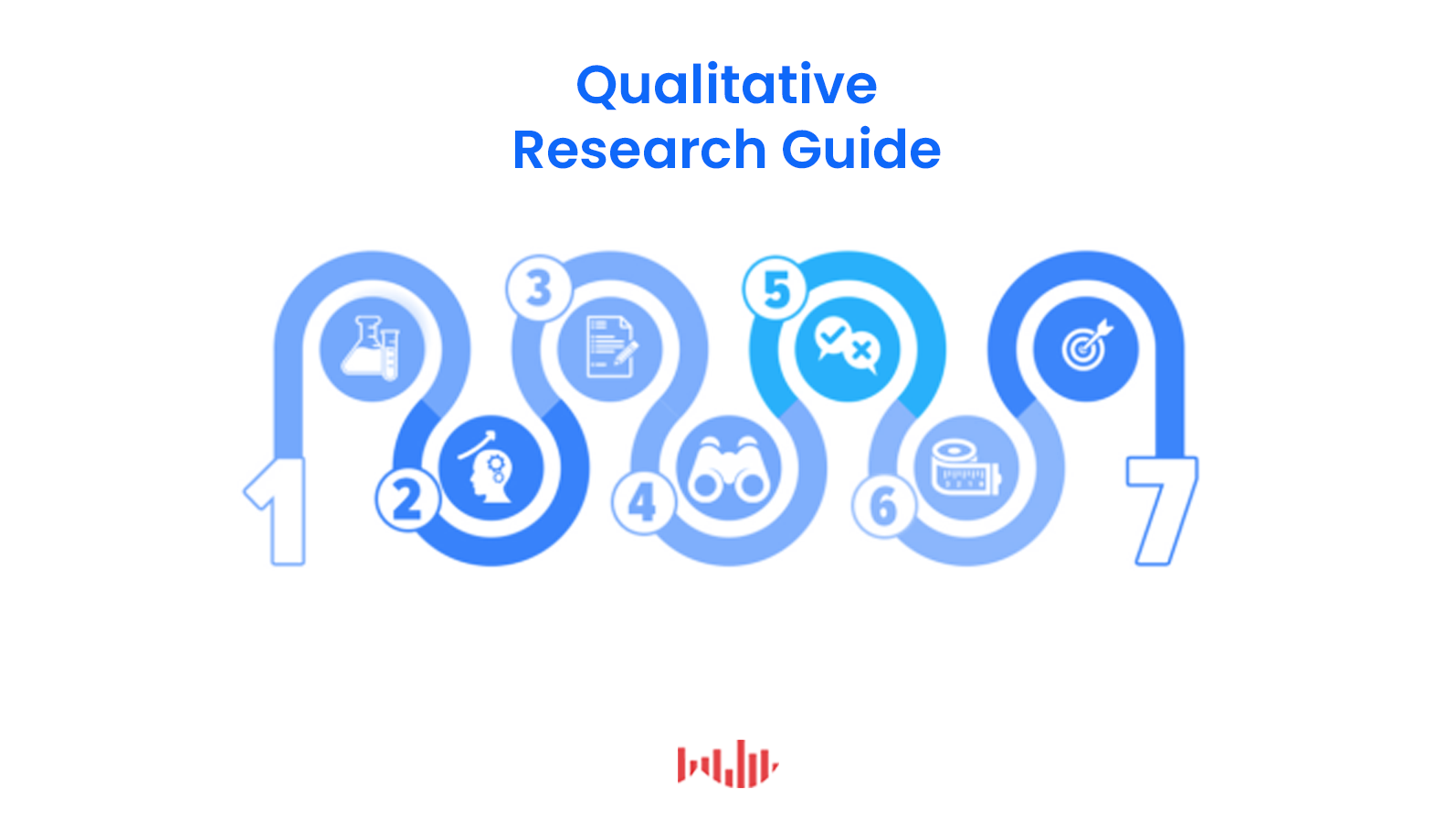 Qualitative research is one of the most prominent research methods in the ever-increasing research sphere. Running counter to quantitative research, qualitative research encompasses a distinct set of differentiating qualities (no pun intended). These attributes prove that these two methods ought not to be used interchangeably.
Qualitative research is one of the most prominent research methods in the ever-increasing research sphere. Running counter to quantitative research, qualitative research encompasses a distinct set of differentiating qualities (no pun intended). These attributes prove that these two methods ought not to be used interchangeably.
So what exactly is qualitative research? At a glance, this type of research method seeks to gather in-depth data about a phenomenon without focusing on numerical data or on quantities.
But there is much more to this kind of study method. Learn holistically about qualitative market research with this complete guide.
What Defines & Makes Up Qualitative Research?
Qualitative research is centered around experiences, ideas and opinions. As such, it does not focus on statistical or quantitative outcomes. Instead, it seeks out an in-depth understanding of an issue, occurrence or phenomenon.
Thus, this research method zeroes in on the “what” and more importantly, the “why” of a research subject. (Unlike quantitative research, which focuses on the “how much”).
Here are some of the applications of qualitative research:
Understanding an issue in greater depth
Finding the reason behind an occurrence (whether it’s desirable or undesirable)
Uncovering trends in target market opinions
Forming educated solutions to address customer/studied subject concerns
Discovering the causes of certain actions
Qualitative research generally relies on a smaller sample size in order to get a deep read of happenings, causes and motivations. This kind of research method functions through the usage of open-ended and exploratory questions.
Understanding the “why” behind an issue is then used to make decisions on how to resolve the issue or how to improve on an existing productive situation.
Qualitative data must occur in natural environments. This denotes a kind of environment in which participants discuss their opinions at length and at ease, which researchers use to gain deeper knowledge and form inferences around a topic.
Prior to the internet, this kind of research was conducted in-person, but with the advent of the internet and innovations in market research, qualitative data has been collected online. The digital space can also serve as a natural environment.
The Five Main Types of Qualitative Research
Just as with quantitative research, there is not a single approach to conducting qualitative research. On the contrary, there are five main varieties of performing qualitative research. Aside from their methodology, these sub-categories also seek different types of answers and conclusions.
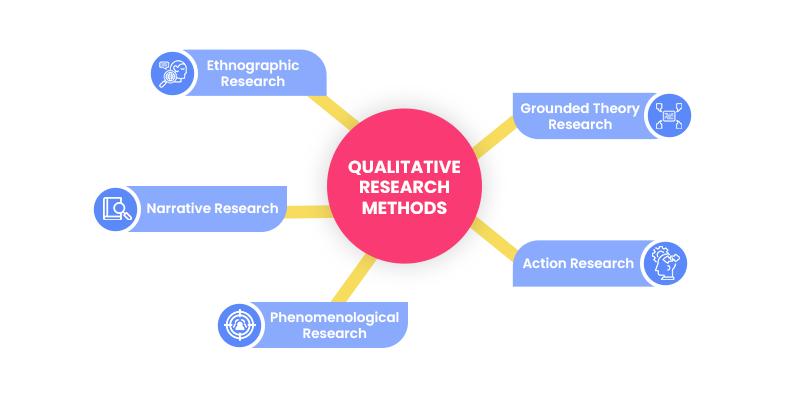
1. Narrative Research
This research is used to form a cohesive story, or narrative, by way of consolidating several events from a small group of people. It involves running in-depth interviews and reading up on documents featuring similar actions as a means of theme-searching.
The point of this is to discover how one narrative is shaped by larger contextual influences. Interviews should be conducted for weeks to months and sometimes even for years. The narrative that the researcher uncovers does not have to be presented in sequential order.
Instead, it should be projected as one with defined themes that attempt to reconcile inconsistent stories. This method can highlight the research study’s ongoing challenges and hardships, which can be used to make any improvements.
2. Ethnographic Research
The most common qualitative research method, ethnography relies on entrenching oneself in various participant environments to extract challenges, goals, themes and cultures.
As the name suggests, it involves taking an ethnographic approach to research, meaning that researchers would experience an environment themselves to draw research. Using this firsthand observation, the researcher would not need to then rely on interviews or surveys.
This approach may seem to be far-fetched where market research is concerned, but it is doable. For example, you’d like to see the effectiveness or frustration that customers face when using your product. Since you can’t follow them home, you can request videos that show them using it. Many big brands have call-outs on their websites (ex: on product pages) for their customers to send in videos of their interactions with the products.
3. Phenomenological Research
This qualitative method entails researchers having to probe a phenomenon or event by bringing lived experiences to light and then interpreting them. In order to achieve this, researchers use several methods in combination.
These include conducting surveys, interviews and utilizing secondary research such as available documents and videos on the studied phenomenon. Additionally, as in ethnographic research, phenomenological research involves visiting places to collect research.
These will help you understand how your participants view your subject of examination. In turn, you will gain insight into the participants’ motivations.
In this research type, you would conduct between 5 and 25 surveys or interviews, then peruse them for themes. Once again, you would scrutinize experiences and sentiment over numerical data.
4. Grounded Theory Research
In contrast to phenomenological research, which seeks to fully form the core of an issue, grounded theory attempts to find explanations (the why) behind an issue. To achieve this, researchers use interviews, surveys and secondary research to form a theory around the issue/occurrence.
The sample of this study tends to be on the larger side, at 20-60 participants. Data extracted from this type of research is interpreted to determine the reasoning behind, for example, heavy usage of or frustration with a product. These types of studies help a business innovate an existing product by getting into the weeds of how it’s used.
5. Action Research
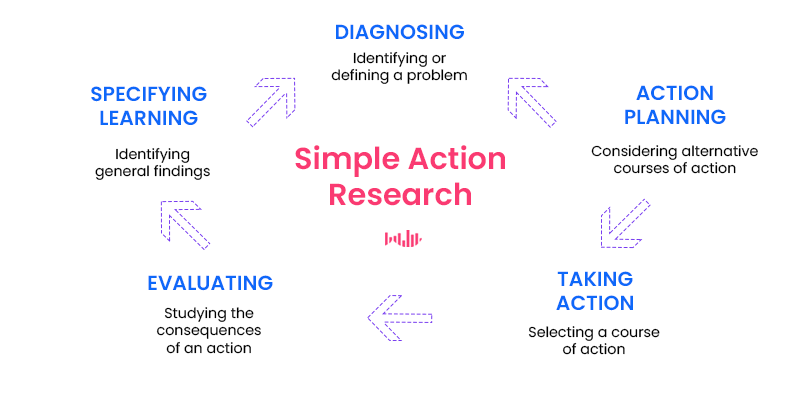
This type of research involves researchers and participants working collaboratively to bring theory to practice. Also called participatory research, collaborative inquiry, emancipatory research and action learning, this method entails the act of “learning by doing.”
This means a group of researchers come together to find and address a problem, resolve it and then study the success of their endeavors. If they underperformed or their outcomes don’t satisfy their expectations, they would then reattempt the process.
In action research, a researcher spends a considerable amount of time on collecting, analyzing, and presenting data in an ongoing, periodic process. This involves researchers coming up with their own surveys and interviews around a subject matter, then presenting their findings to one another to draw conclusions and solutions.
They would put into practice the means to improve a situation and continue measuring their success throughout the process.
Examples of Questions for Qualitative Research
When working within the capacity of any of the above research types, it’s crucial to ask the right questions. Here you’ll find the questions you can use when conducting each of the five types of qualitative research.
Bear in mind that some of these questions will appear to be similar in nature; some are even interchangeable. That is normal, as researchers may search for the same answers, but apply a different approach in their research method.
In any case, all of the below features questions that fit within the larger qualitative research framework.
Learn more about asking insightful market research questions. Here are a few examples of the questions within the five categories:
1. How do people who witnessed domestic violence understand its effects in their own relationships?
Variable: Views of domestic violence on one’s own relationships
Demographic: People in relationships, who’ve witnessed domestic violence
Qualitative Research Type: Narrative
2. What are the lived experiences of working-class Americans between the ages of 20 and 40?
Variable: Experiences and views of a working-class background
Demographic: Working-class Americans ages 20-40
Qualitative Research Type: Narrative
3. How do Asian Americans experience reaching out to address mental health concerns?
Variable: The experiences in seeking out care for mental health
Demographic: Asian Americans seeking help for mental health
Qualitative Research Type: Ethnographic
4. What do you enjoy about this product or service?
Variable: The positive experiences of using a particular product/service
Demographic: The target market of a product or service
Qualitative Research Type: Ethnographic
5. How have people who have experienced poverty changed their shopping habits when they entered the middle (or higher) class?
Variable: The changes or stagnation in shopping habits
Demographic: those who experienced poverty, but climbed the social ladder
Qualitative Research Type: Phenomenological
6. What was it like when you had a negative online shopping experience?
Variable: unpleasant shopping experiences
Demographic: a group that is most likely to shop at a particular online store
Qualitative Research Type: Phenomenological
7. What influences managers in private sectors to seek further professional advancement?
Variable: Motivation for seniority
Demographic: Managers in the private sector
Qualitative Research Type: Grounded Theory
8. How do women in third world countries set up financial independence?
Variable: Efforts at reaching financial independence
Demographic: Women in third-world countries
Qualitative Research Type: Grounded Theory
9. What impact does collaborative working have on the UX optimization efforts of a telecommunications company?
Variable: effects of collaboration on the UX of a telecommunications company
Demographic: workers in the telecommunications space
Qualitative Research Type: Action Research
10. What strategies can marketing managers use to improve the reach of millennial customers?
Variable: Strategies to improve millennial reach and their outcomes
Demographic: Marketing managers
Qualitative Research Type: Action Research
When to Use the Research and How to Analyze It
The qualitative research method has specific use cases. You ought to consider which is best for your particular business, which includes your strategy, your marketing and other facets.
The core of qualitative research is to understand a phenomenon (a problem, an inadequacy, and a slew of other occurrences) including its causes, its motivations, its goals and its solutions. Researchers do this by observing smaller portions of a population.
Researchers should use this form of research whenever you need to get the gist of a particular occurrence or event. It is particularly useful for studying how your target market experiences certain situations and how it feels about them.
There are several more specific ways that elucidate why this research style is valuable if not completely necessary. Here are some of the most crucial ways this method of research is vital:
Helps brands see the emotional connections customers have with them
Allows brands to find gaps in customer experience (CX) and user experience (UX)
Enables brands to create experiences that are more tailored to their target market
Helps businesses understand how they can improve on their product, service or CX
Finds experiences that customers had that highlight sensitive topics/language for them
Shows businesses how customers compare them to their competitors
Identifies possible solutions and innovations based on customer attitudes and experiences
To analyze qualitative research, you should first identify your subject of study and decide on the type of research you need to conduct based on the five types of research that fall under the qualitative category.
Then, brainstorm several questions that you can use to form the base of your studies. During the process make sure to jot down (either digitally or otherwise) your observations. For example, record interviews and store surveys in an organized database.
Make sure you ask open-ended questions in surveys, interviews, focus groups, et al. Aggregate secondary research such as government database documents, articles in your niche, images, videos and more.
Search for patterns or similarities within your findings. When you group them together and organize them by demographics, you can start drawing conclusions and proposing solutions.
The Benefits and Drawbacks of Qualitative Research
Qualitative research can be extraordinarily beneficial. But as with other aspects of research and beyond, it too comes with a set of drawbacks. As a business owner, marketer or market researcher, you should know both the pros and cons. Here are some notable ones:
Benefits
More intimate understanding of context and causation: besides understanding “what” in a granular way, you also learn the “why” and “how” of a particular situation.
Understanding key experiences: Open-ended questions lead to unique answers, exposing things numerical-based surveys can’t answer.
A foundation of deep insights: The design of the study is made to understand how customers relate to particular occurrences, events, ideas and products.
Context-driven: Finding insights on motivation and past behaviors allows researchers to understand what their target market needs and what it tries to avoid.
No need to find and create the correct measuring units: Open-ended questions don’t require a scale, a number range or any other measuring tools — one less thing to worry about.
Smaller sample size: Smaller sample sizes allow researchers to study responses more thoroughly to form more accurate hypotheses and conclusions.
Inspirational: The responses received can also help researchers form new studies.
Flexible and detail-oriented: Since questions aren’t based on scales and other units, you can ask more creative and in-depth questions. Questions focus on details and subtleties for robust insights.
Drawbacks
Relies on researcher experience: It relies on the researchers’ experience; not all are familiar with industry topics.
Not statistically representative: Only collects perspective-based research; does not provide statistical representation. Only comparisons, not measurements can be executed.
Difficult to make copies of data. Individual perspectives make it hard to replicate findings, making it it more difficult to form conclusions.
More likely to have researcher bias: Both conscious or subconscious of the researcher can affect the data. The conclusions they draw can thus be influenced by their bias. (This can be avoided by using controls in data collection.
The Final Word
Market research is a wide-spanning undertaking. It has a wide swath of aspects, practices and applications. As such, researchers should know its main categories and qualitative research is one such category of significance.
As opposed to quantitative research, which has four methods, qualitative research has five — not all of which will be of use to your particular market research needs. In any case, this type of research involves imbuing as much context and particularities around a phenomenon as possible.
As such, researchers should create questions more specific to the aforementioned examples of this article. That is because those are more encompassing, generalized questions that researchers can attempt to answer after conducting all of their research and parsing of the findings.
But prior to that, researchers should ask several related questions around a particular topic and tailor those questions as best as possible to the target audience.
Frequently asked questions
What is qualitative research?
Qualitative research is a type of research that is conducted to gain deep or unexpected insights rather than focusing on numeral or quantitative data.
Why is qualitative research conducted?
Qualitative research is conducted to find the “why” of the research subject, rather than the “what’ of that subject. For example, qualitative research might be conducted to understand an issue more deeply, to understand why something is happening, or to learn how to address a target market’s concerns.
What is narrative research?
Narrative research is a type of research that is used to create an in-depth story about a phenomenon or event. It is conducted by interviewing a small group of people who were directly involved in the event.
How is ethnographic research conducted?
When conducting ethnographic research, the researchers use firsthand observations of an environment to more deeply understand the goals, challenges, or opinions of the target audience.
What is action research?
Action research is a type of qualitative research in which researchers and participants collaborate to better understand a phenomenon. Together the group works to find and solve the problem by gathering information on an ongoing and evolving basis.
Diving into the Business Survey for Building Success
Diving into the Business Survey for Building Success

If you own or operate a business, you need a business survey. Although you might know plenty about the intricacies of how your business operates from the inside, that knowledge alone might not be enough to propel your company into its next round of success.
Customer feedback, customer satisfaction, employee morale, upcoming market trends — knowing all this separates thriving companies from businesses that are just one bad decision away from a crisis.
And a business survey is a shortcut to this knowledge.
In this article, we cover how companies use business surveys to operate effectively and without hesitation, and how said surveys inform critical business decisions in today’s fast-paced and uncertain environment.
Defining a Business Survey
A business survey is a survey that allows you to gather data and insights that can be used to enhance various aspects of your business.
Using business surveys, companies can either acquire new knowledge about markets and target audiences while exploring fresh opportunities for growth. At the same, time business surveys can be used to fill the gaps in the existing knowledge of company operations, boost employee performance, and optimize expenses.
Although the data gathered during such research can be used in myriad ways, we recommend setting a specific goal for every business survey to keep your insights focused and actionable.
Applications Of Business Surveys
Due to the high level of customization that surveys provide, business surveys offer a wide range of applications and can be optimized for producing all kinds of value for businesses.
Here are some of the common applications for business surveys:
- Enhancing customer personas. Business surveys allow you to learn more about your customers, their habits, and what they think about your company and products. Studies show that 82% of marketers improved their value proposition using well-developed customer personas.
- Learning more about the new markets. Expanding into new markets and platforms is one of the surest ways to grow your business, but it comes with lots of uncertainty. Business surveys help step into the new territory with more confidence and hard-proof data.
- Increasing customer retention levels. Knowing when your customers are happy with your product is as important as knowing when they are not. Use business surveys to keep track of what your customers think about your products and brand before they start turning to your competition. In addition to that, the mere act of conducting surveys may increase customer retention levels as clients feel more taken care of.

- Improve employee performance. Business surveys can be used to inspect the state of your workforce on several levels via employee feedback: employee motivation, team trust, and management efficiency. With business surveys, you can reveal issues that certain departments experience and address them before the problems affect the rest of the company.
5 Types Of Business Surveys
You can use the following types of business surveys to gain a 360-view of your business, inform your growth strategy, and enhance customer satisfaction levels.
Customer Satisfaction Survey
There are five types of customer satisfaction surveys that allow you to gauge customers’ opinions about your products and company. One of the most commonly used is the Net Promoter Score (NPS) survey, which that checks measures how much your audience is willing to recommend your products to their inner circle.
The NPS survey allows you to segment your audience into three major groups known as detractors, passives, and promoters. The more promoters your business has, the higher will be your organic growth. It’s the other way around with detractors.
Regular customer satisfaction surveys are extremely important in case your business relies on organic growth as they allow you to keep track of how happy your customers are over time and correct your course in case recent decisions stagnated your expansion.
Example question: On a scale of 0-10, how likely are you to recommend our product to a friend or colleague?
Market Research Survey
Market research surveys are a wide group of surveys designed to learn more about the market you currently operate in or gain additional knowledge in case you want to expand into new niches.
These surveys may include demographic surveys designed to gather more data about your current and potential customers, platform-specific surveys such as e-commerce market research, technology market research, market trends research, and surveys designed to enhance various marketing-related activities, e.g. advertising market research
Example question: What are your main social media channels that you use to learn about new products?
Employee Satisfaction Survey
Employee satisfaction surveys are designed to collect information about the general feelings of your employees, their level of motivation, and any roadblocks that might be preventing them from doing their job more effectively.
These types of business surveys are often conducted in companies that want to enhance the performance of their employees or address issues during a transitional period (e.g. company-wide switch to remote work, company buy-out, or a new HR policy).
One of the variations of these surveys is an employee exit survey that aims to determine employee’s reasons for applying for a job or their reasons for leaving the company.
Example question: Are there any roadblocks that currently prevent you from operating at your maximum level of efficiency?
Brand Awareness Survey
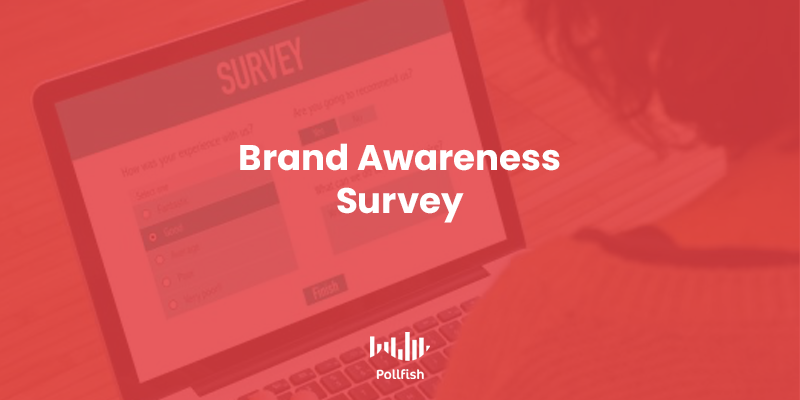
Brand awareness surveys aim to elicit customer’s opinions and feelings about your brand.
Brand perception is an encompassing term and may be affected by many factors such as PR-relationships of your company, public stance on local and global issues, and the general representation of your brand in media.
Brand surveys help companies to reveal the current brand perception by their customers and track whether it has been recently affected.
A brand awareness survey can also reveal whether your target market is able to identify your brand, i.e., know of its existence. This is especially important when it comes to differentiating your brand from competitors.
Example question: Which of the following brands have you heard of? (Include your business)
A well-established branding policy has many benefits such as a higher number of positive online reviews, an increase in customers’ trust, and revenue growth.
Example question: Where have you seen or heard about our brand in the last several months?
Product Satisfaction Survey
The product satisfaction survey is closely related to customer satisfaction surveys, but with a focus on your product.
Business surveys that are focused on your product may help you to check whether customers know about your product, if they find your product appealing, discover how your product compares to the competition, and gather quality insights on how it can be improved in the future.
Example question: How long have you used [your product]? Or
What would you like to be improved in [your product]
The Role of Business Surveys In Growing Your Company
There’s no lack of data in our digital age, and often companies are confused and disoriented with the amount of information they gather through various analytical tools and 3rd party data providers.
But business surveys don’t add to this chaos. Instead, they allow businesses to gain a birds-eye view of their whole organization while referring to the most relevant and reliable source of truth: their customers and employees.
Insights gathered through business surveys often allow organizations to organize and enliven previously disjointed sources of data into more coherent and actionable formats.
If you want to see for yourself how business surveys can fuel your company’s growth and obtain trustful and impartial data directly from your target audience, try our market research platform, which makes it easy to create and deploy all kinds of surveys, along with analyzing them in different formats.
Frequently asked questions
What is a business survey?
A business survey is any type of survey that is conducted in order to improve or enhance certain aspects of a business.
What are some reasons for conducting a business survey?
Business surveys may be conducted in order to gain new knowledge about target markets, better understand company operations, improve employee morale and performance, and/or improve a company’s profitability.
What are some examples of business surveys?
There are many different types of business surveys, including customer satisfaction surveys, market research surveys, employee satisfaction surveys, brand awareness surveys, and product satisfaction survey
How can a business survey help a business better understand its target market?
A business survey can provide an in-depth view into customer habits, feelings, and attitudes, which can then be used to develop customer personas. Customer personas allow businesses to understand their customers so they can develop better products, services, features, and market campaigns.
How can a business survey improve customer retention?
Studies have shown that the simple act of conducting a business survey may help improve customer retention rates since customers feel that the business genuinely cares about their needs and concerns.
How to Conduct Market Research for Nonprofits Like a Pro
How to Conduct Market Research for Nonprofits Like a Pro
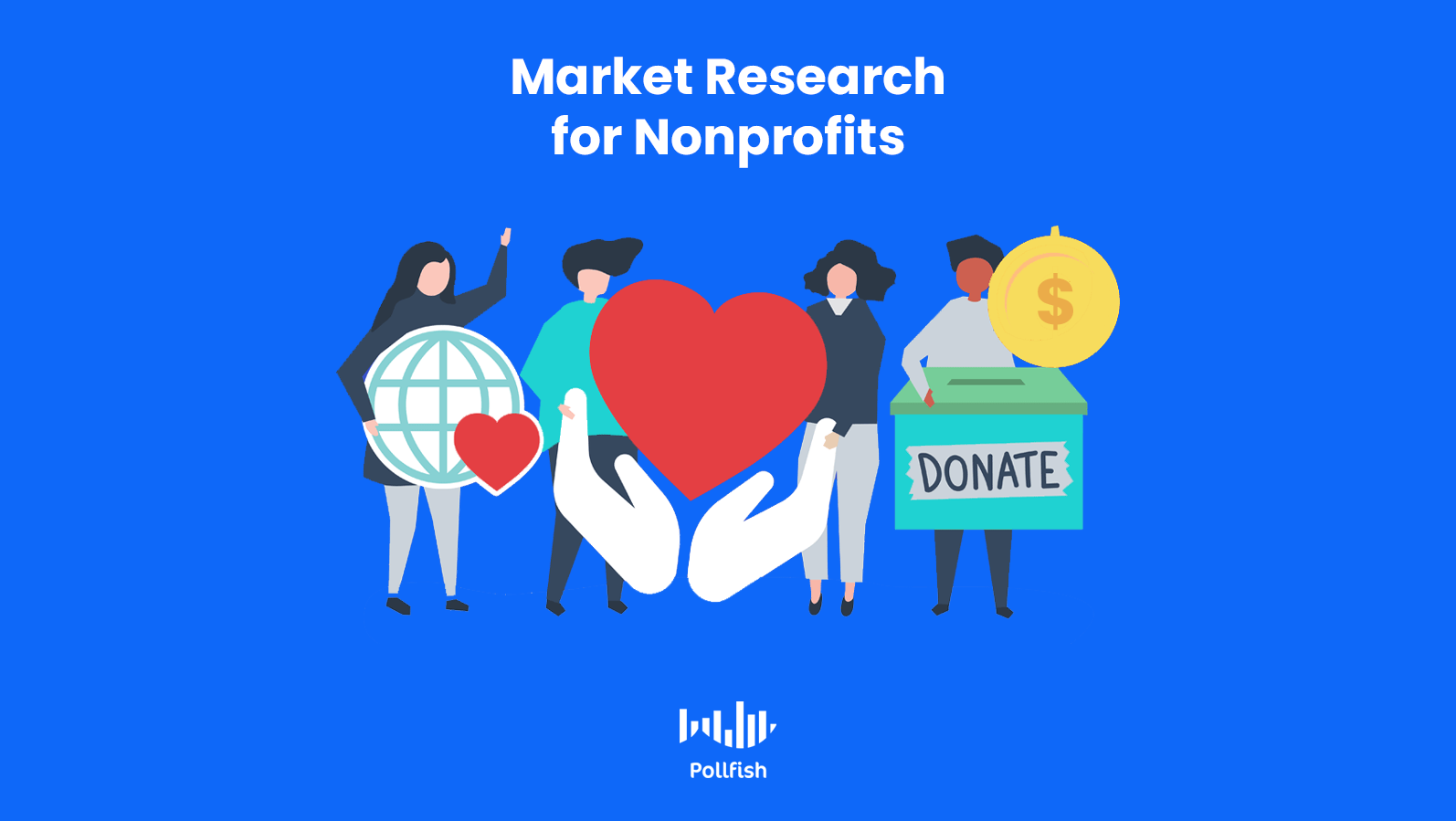
Market research for nonprofits is a necessary action that can help you secure funding and remain financially stable. With over 1.5 million nonprofits operating in the United States, competition for funding is fierce. To make things even more challenging, in recent years the donor retention rate has hovered around 40%.
Nonprofits cannot assume that existing donors will continue to support them. They must find innovative ways to demonstrate the value of their organization in order to secure new donors and retain existing ones.
By better understanding your target audience, you can create a more effective strategy to connect with your supporters, understand them better, rap in more funds and dutifully support your cause. In this guide, we will help you understand how to conduct market research like a pro, with a few key takeaways to help you get your market research started on the right foot.
The Purpose of Market Research for Nonprofits
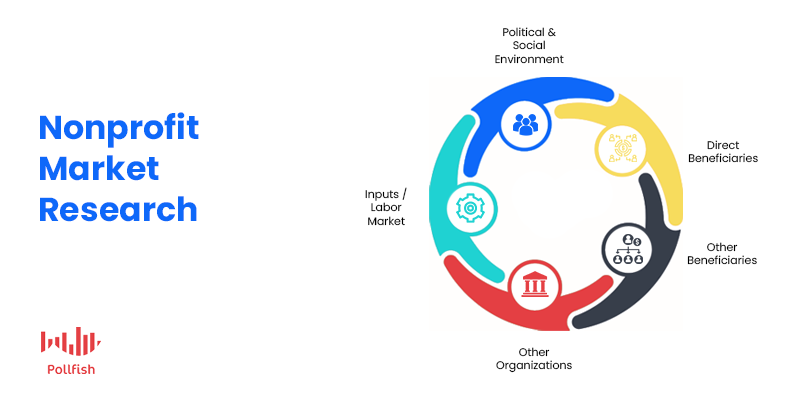
There are several reasons why an NPO may consider undertaking market research, but all of these reasons lead back to the same goal, to ensure that enough funding is secured to keep the organization running. There is a finite amount of money that can be sourced from your supporters; market research can help inform and strengthen aspects of your overall funding strategy.
The main purpose of market research for nonprofits, therefore, is to understand their donors’ demographics and preferences. By understanding this, NPOs can find more effective ways to reach donors and improve ROI for marketing campaigns, which are almost always run on a tight budget.
While the purpose of market research is to better understand your audience, you will need to be more specific about the objectives of your market research in order to gain insights that you can use. Consider exactly what you hope to achieve before you get started. You may consider undertaking market research for some or all of the following reasons:
- Gain a better understanding of your donor base. Understanding the characteristics of your existing donors will allow you to make informed decisions for your nonprofit.
- Grow your brand. Insights about your existing supporters and those in your target audience can help you develop your brand to make it more appealing to your base.
- Improve communication with your supporters. An effective communication strategy is essential to retain existing donors and encourage them to give year-to-year. By understanding your supporters more deeply, you will be able to create more targeted messages to the various segments.
- Enhance your marketing efforts. Use insights gained about your support base to improve your marketing efforts by creating campaigns that will speak to your base. When operating with a smaller marketing budget, it is vital to achieve optimal conversion rates and ensure marketing funds are well spent.
- Leverage your base to test new approaches. Connect with your existing supporters to trial news ideas before making big changes to your marketing strategy or your mission.
- Measure current communications and campaigns with your supporter base. Gauge the reception of existing communications and level of frequency with your supporter base.
- Compare your nonprofit with others in your niche. Understand how you measure up to other players in the field to ensure you remain attractive to prospective donors.
- Measure brand awareness. Observe how aware or receptive your target market is to your nonprofit so you can make adjustments and increase your audience.
- Ensure that you are operating in a cost-effective manner. Every penny counts. Understanding your audience will ensure optimal ROI on each marketing campaign and initiative you undertake.
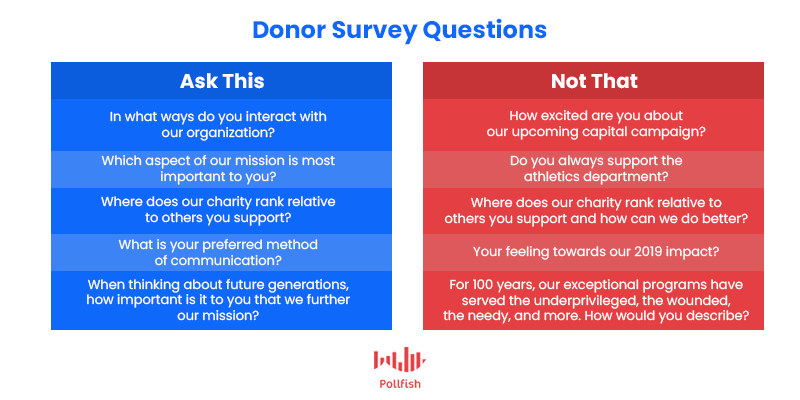
The Makeup of Market Research
Your market research project will cover two types of research: primary and secondary. The objective(s) of your market research project will dictate the selection of primary and secondary sources that you need.
Primary Research
Primary research involves gathering and analyzing data from first-hand sources. This means that the information you gather during primary research will be highly relevant and unique to your organization. The primary research methods for nonprofits are:
- Surveys of existing and/or targeted supporters
- Interviews (in person or by phone)
- Focus groups
- User testing (for example, if trialing a new social media or email campaign)
Primary research is an essential tool to better understand your existing donors. Primary research can help you explore aspects such as their reasons for giving, how your brand makes them feel, and what will motivate them to give again.
Secondary Research
When conducting secondary research, you will gather and examine information that is already published and publicly available. Examples of secondary research include:
- Market research papers
- Case studies and white papers
- Research agencies
- Statistic sites
- Industry reports
- Government statistics
- SEO and keyword research
- Trends sites (e.g. Google Trends)
- Websites of other nonprofits operating in a similar sphere
There is a wealth of information readily available for nonprofits - the trick is to identify which of this information is applicable to your organization.
Secondary Research Sources for Nonprofits
To help kickstart your market research, we have compiled a list of secondary research sources for the nonprofit sector.
- NCCS data - The National Center for Charitable Statistics (NCCS) is a vital source of free information and statistics about nonprofits. In order to make sense of the huge amount of data available here, start by reading the Beginner’s Guide to Using NCCS Data.
- The Nonprofit Sector in Brief 2019 - The NCCS publishes a yearly report that provides an overview of the nonprofit sector in the United States. The report includes info on key aspects of the sector, such as size and scope, types of organizations, and donation amounts.
- IRS’s Nonprofit Tax Statistics - The IRS publishes statistics about the tax-exempt sector that can be used to better understand both recent trends and historical data.
- Statista - An excellent source of statistics on any topic imaginable, Statista has a sizeable collection of nonprofit statistics. There is some free information about nonprofits available, while their dossier on nonproft organizations in the United States provides an in-depth view on the sector.
- Propublica’s Nonprofit Explorer - This tool lets you view tax returns for certain tax-exempt organizations in the United States. This information can be used to give you a better understanding of businesses with similar operating models.
Drive Your Market Research with First-Hand Insights
While secondary research provides a strong understanding of the nonprofit sector, primary research is highly necessary to understand how your target market thinks and behaves.
Fortunately, nonprofits have something that many other companies do not — an enthusiastic audience that has already demonstrated a commitment to your brand. Finding a way to reach these supporters and leverage their opinions can help you form future decisions, whether they be monetary, communications-based or deal with outreach.
Whether you have a large existing donor base or a small one, online surveys are a cost-effective way to gather information that can help improve your organization. Use social media or email to ask your supporters to participate in surveys, focus groups, and interviews; after all, this group of people should feel motivated to help you.
The involvement of existing donors in your market research project can help you make much more sense of the data you will accumulate. When you combine survey data on the sector, and you’ll be on your way to more certain financial stability.
Frequently asked questions
What is market research for nonprofits?
Market research for nonprofits is the process of better understanding the target market for a nonprofit to help secure funding and remain financially viable.
How can nonprofits benefit from market research?
Nonprofits can benefit from market research in a variety of ways, such as gaining a better understanding of existing donors, improving communications with existing and potential supporters, improving marketing efforts, and growing their brand.
What types of primary research are beneficial when conducting market research for nonprofits?
The most relevant types of primary research for nonprofits are surveys, interviews, focus groups, and user testing.
How can nonprofits use secondary research sources to support a market research project?
Nonprofits can examine published data in order to better understand trends and statistics in order to see how they compare to other nonprofits in their sector.
How are surveys used to drive market research for nonprofits?
Nonprofits tend to have an involved and interested user base. These individuals are more likely to participate in surveys and provide valuable responses that can help shape future campaigns to secure funding and donor retention rates.
Diving into the Consumer Survey
Diving into the Consumer Survey

A consumer survey is an essential tool for business owners who want a broader understanding of consumer attitudes, desires, and interests before launching a new product, feature, or service.
With the advent of online survey platforms, consumer surveys have become much easier to deploy. In comparison to traditional methods of face-to-face interviews or paper questionnaires, online surveys are more cost-effective and less time-consuming to conduct.
It is now easier for any entrepreneur to launch a consumer survey to understand customer sentiment around a new product or service. This article provides an overview of consumer surveys and suggestions on how to get started.
What Is a Consumer Survey?
Consumer surveys are an increasingly common method of conductinig consumer research. Surveys can be broadly and easily distributed, leading to a higher response rate than other market research methods. With the capability of gathering large sample pools, it is easier to identify trends and patterns among consumers through an online consumer survey.
Consumer surveys are used in two different ways:
- To determine consumer interest in new products, features, or services
- To understand satisfaction with existing products or services
Depending on the purpose of your research, a consumer survey could be distributed to existing customers or to a group of people who have no experience with your company but fall within your target market.
For established businesses, consumer surveys are a great way to understand how existing customers use your product or service, while gauging their interest in potential new features or services.
For entrepreneurs or investors, consumer surveys can help you understand the desires or aversions towards your business idea. Taking the time to perform a consumer survey can help you understand if your idea will succeed or flop.
Complete Enumeration vs. Sample Survey
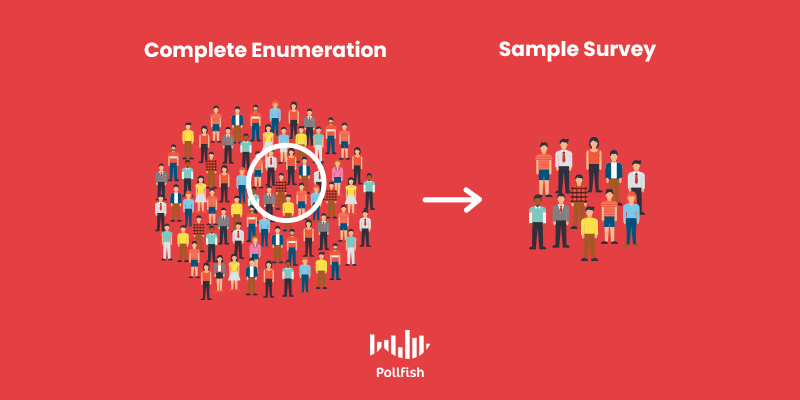
Before you begin planning your survey, you will need to consider which consumer survey method will best serve your purposes.
- Complete enumeration method: With this method, you will need to contact nearly all potential buyers or existing users of your product. A major benefit of this consumer survey method is that it eliminates sampling bias since the entire population is included in the results. Complete enumeration can be challenging in situations where the survey population is large and/or distributed across a wide geographic area.
- Sample survey method: As the name implies, this method involves distributing surveys to a sample of your population and drawing conclusions based on their responses. In comparison with the enumeration method, this type of survey is easier to conduct and more cost-effective; however, you must scrutinize the results to ensure that sampling bias is not skewing your interpretation.
Consumer Survey Types
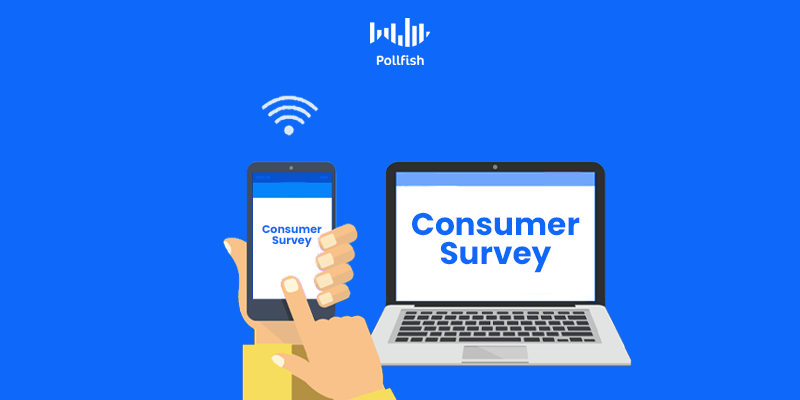
There are three primary ways to conduct a consumer survey. These methods describe the mode of gathering information from consumers. Each has its own set of pros and cons.
Telephone Surveys
Before the advent of online surveys, telephone surveys were a fundamental component of market research.
Phone surveys allow you to gain more detailed responses to open-ended questions, as opposed to written surveys, in which open-ended questions are likely to be omitted, given their more laborious and time-consuming nature.
On the other hand, it may be difficult to get respondents to complete your survey, resulting in a lower response rate. The skill of the interviewer and level of interest in the topic will help determine whether the respondent will agree to complete the survey or not.
Written Surveys
Written surveys can be successful when researchers have an effective mode of distribution that gets the surveys into the hands of an interested audience. Just like online surveys, written surveys must be thoughtfully designed to encourage a satisfactory response rate.
Written surveys are often used to obtain information about more sensitive topics. A benefit of written surveys is that they can be completed at a time convenient for the respondent, which may be more suitable if you are researching a sensitive topic.
Conversely, without anyone encouraging the completion of the survey, the response rate of mail-in surveys are lower than that of telephone or online surveys. Many business owners will hire a company to conduct their written survey to ensure they get a large enough sample size.
Online Surveys
With the innovation of reliable online survey platforms, online surveys are now the most commonly used type of consumer research surveys. Online surveys can be distributed in a variety of ways, including via website, email, social media, or in-app.
The benefits of online surveys are numerous. This type of survey can be:
- Distributed to a wide audience in every part of the world.
- Designed with skip-logic to route respondents to relevant questions only based on their previous answers.
- Customized with user-friendly UX elements such as graphics, larger text, and call-outs to generate higher response rates.
- Deployed by the business owner via the online survey platform without needing to engage a third party.
The results of an online survey are viewed in a specialized dashboard, making it easy to review, filter, and download survey data. A potent online survey platform will also grant you the capability of viewing the data in various formats, such as through graphs, charts, and cross-tabs. Online surveys are cost-effective, so you can conduct several surveys as part of your broader consumer research project.
Wrapping Things Up on Consumer Surveys
Consumer surveys are incredibly useful tools for conducting market research. Most importantly, these surveys give you firsthand insight into customer experience, a critical business aspect that can make or break your brand.
In fact, 84% of customers feel that their customer experience is just as important as a company’s products and services. Measuring customer experience goes hand in hand with measuring customer satisfaction, another key aspect of the business.
Since you will likely need to deploy a variety of surveys, consider using a professional survey platform that will make it easier to review a large volume of data over time. In addition, survey platforms like Pollfish can help you get your survey in front of the right audience, ensuring that your data analysis will accurately shape the future of your business.
Frequently asked questions
What is a consumer survey?
A consumer survey is a type of survey used in consumer research to understand consumer interest in a new product, feature, or service, or to understand consumer satisfaction with an existing product, feature, or service.
What is the complete enumeration method?
Complete enumeration is a method in which a survey is distributed to nearly every customer of a product or service. Complete enumeration eliminates sampling bias since an entire population participates in the survey.
What is the sample survey method?
The sample survey method involves distributing a survey to a smaller portion of the population, with the aim of accurately representing the overall population. Care must be taken to avoid sampling bias in order to ensure accurate results.
What is a telephone survey?
A telephone survey is one in which participants answer survey questions via phone. This type of survey was more popular before the widespread use of online surveys.
What are some benefits of an online survey?
Online surveys are easy to distribute to the target audience, regardless of geographic location, can provide a better response rate, and can yield more interesting results through the use of skip-logic to send respondents to more relevant questions.













